Magnetic Fly Ash as a Chronological Marker in Post-Settlement Alluvial and Lacustrine Sediment: Examples from North Carolina and Illinois
Abstract
1. Introduction
2. Geologic and Historical Setting
2.1. North Carolina Piedmont Study Area
2.2. Central Illinois and Lake Decatur
3. Methods
3.1. Soil Sampling
3.2. Magnetic Fly Ash Extraction
3.3. Counting of Magnetic Spheroids
3.4. Magnetic Susceptibility
3.5. Post-1850 Alluvial Thickness Determination
3.6. Scanning Electron Microscopy
3.7. Carbon Isotopes, Carbonate Content, and Cesium-137
4. Results
4.1. Field Observations: (North Carolina Alluvium)
4.2. Magnetic Fly Ash (North Carolina Alluvium)
4.3. Scanning Electron Microscopy
4.4. Magnetic Susceptibility (North Carolina Alluvium)
4.5. Post-1850 Alluvium Thickness (North Carolina–Illinois Comparisons)
4.6. Fly Ash Records in Milldam and Reservoir Lake Sediments
4.6.1. Betty’s Milldam, North Carolina
4.6.2. Lake Decatur, Illinois
5. Discussion
5.1. Magnetic Fly Ash as a Chronological Tool
5.2. Controls on Sedimentation and Preservation of Magnetic Fly Ash in Alluvial Records
5.3. Comparisons of Post-Settlement Alluvium Thickness in Central North Carolina and Illinois
5.4. Fly Ash Records in Milldam and Reservoir Lacustrine Sediments
6. Conclusions
Supplementary Materials
Author Contributions
Funding
Data Availability Statement
Acknowledgments
Conflicts of Interest
References
- Jones, R.L.; Olson, K.R. Fly ash as a time marker in sedimentation studies. Soil Sci. Soc. Am. J. 1990, 54, 855–859. [Google Scholar] [CrossRef]
- Hussain, I.; Olson, K.R.; Jones, R.L. Erosion patterns on cultivated and uncultivated hillslopes determined by soil fly ash contents. Soil Sci. 1998, 163, 726–738. [Google Scholar] [CrossRef]
- Rose, N.L. Fly Ash Particles. In Tracking Environmental Change Using Lake Sediments: Volume 2: Physical and Geochemical Methods; Last, W.M., Smol, J.P., Eds.; Kluwer: Dordrecht, The Netherlands, 2001; pp. 319–349. [Google Scholar]
- Rose, N.L. Spheroidal carbonaceous fly ash particles provide a globally synchronous stratigraphic marker for the Anthropocene. Environ. Sci. Technol. 2015, 49, 4155–4162. [Google Scholar] [CrossRef] [PubMed]
- Olson, K.R.; Gennadiyev, A.N.; Golosov, V.N. Comparison of fly-ash and radio-cesium tracer methods to assess soil erosion and deposition in Illinois landscapes (USA). Soil Sci. 2008, 173, 575–586. [Google Scholar] [CrossRef]
- Grimley, D.A.; Anders, A.M.; Bettis, E.A., III; Bates, B.L.; Wang, J.J.; Butler, S.K.; Huot, S. Using magnetic fly ash to identify post-settlement alluvium and its record of atmospheric pollution, central USA. Anthropocene 2017, 17, 84–98. [Google Scholar] [CrossRef]
- Locke, F.; Bertine, K.K. Magnetite in sediments as an indicator of coal combustion. Appl. Geochem. 1986, 1, 345–356. [Google Scholar] [CrossRef]
- Patrick, R.; Binetti, V.P.; Halterman, S.G. Acid lakes from natural and anthropogenic causes. Science 1981, 211, 446–448. [Google Scholar] [CrossRef]
- U.S. Energy Information Administration. 2021. Available online: https://www.eia.gov/coal/data/browser/ (accessed on 17 March 2021).
- Cahoon, K.M. Spheroidal Carbonaceous Particles in a Virginia Mill Pond Provide a Record of Local and Regional Coal Combustion. Undergraduate Honors Thesis, The College of William and Mary, Williamsburg, VA, USA, May 2019; 53p. Available online: https://scholarworks.wm.edu/honorstheses/1408 (accessed on 1 March 2021).
- Cowan, E.A.; Seramur, K.C.; Hageman, S.J. Magnetic susceptibility measurements to detect coal fly ash from the Kingston Tennessee spill in Watts Bar Reservoir. Environ. Pollut. 2013, 174, 179–188. [Google Scholar] [CrossRef]
- Harkness, J.S.; Sulkin, B.; Vengosh, A. Evidence for coal ash ponds leaking in the southeastern United States. Environ. Sci. Technol. 2016, 50, 583–6592. [Google Scholar] [CrossRef]
- Brandt, J.E.; Bernhardt, E.S.; Dwyer, G.S.; Di Giulio, R.T. Selenium ecotoxicology in freshwater lakes receiving coal combustion residual effluents: A North Carolina example. Environ. Sci. Technol. 2017, 51, 2418–2426. [Google Scholar] [CrossRef]
- Sarkar, A.; Rano, R.; Mishra, K.K.; Sinha, I.N. Particle size distribution profile of some Indian fly ash—a comparative study to assess their possible uses. Fuel Process. Technol. 2005, 86, 1221–1238. [Google Scholar] [CrossRef]
- Kapicka, A.; Jordanova, N.; Petrovsky, E.; Ustjak, S. Effect of different soil conditions on magnetic parameters of power-plant fly ashes. J. Appl. Geophys. 2001, 48, 93–102. [Google Scholar] [CrossRef]
- Oldfield, F.; Gedye, S.A.; Hunt, A.; Jones, J.M.; Jones, M.D.; Richardson, N. The magnetic record of inorganic fly ash deposition in lake sediments and ombrotrophic peats. Holocene 2015, 25, 215–225. [Google Scholar] [CrossRef]
- Magiera, T.; Jabłońska, M.; Strzyszcz, Z.; Rachwal, M. Morphological and mineralogical forms of technogenic magnetic particles in industrial dusts. Atmos. Environ. 2011, 45, 4281–4290. [Google Scholar] [CrossRef]
- Flanders, P.J. Collection, measurements and analysis of airborne magnetic particulates from pollution in the environment. J. Appl. Phys. 1994, 75, 5931–5936. [Google Scholar] [CrossRef]
- Kapicka, A.; Petrovsky, E.; Ustjak, S.; Machachova, K. Proxy mapping of fly-ash pollution of soils around a coal-burning power plant: A case study in the Czech Republic. J. Geochem. Explor. 1999, 66, 291–297. [Google Scholar] [CrossRef]
- Chudaničová, M.; Hutchinson, S.M.; Hradecký, J.; Sedláček, J. Environmental magnetism as a dating proxy for recent overbank sediments of (peri-) industrial regions in the Czech Republic and UK. Catena 2016, 142, 21–35. [Google Scholar] [CrossRef]
- Hanesch, M.; Scholger, R. The influence of soil type on the magnetic susceptibility measured throughout soil profiles. Geophys. J. Int. 2005, 161, 50–56. [Google Scholar] [CrossRef]
- Blundell, A.; Dearing, J.A.; Boyle, J.F.; Hannam, J.A. Controlling factors for the spatial variability of soil magnetic susceptibility across England and Wales. Earth-Sci. Rev. 2009, 95, 158–188. [Google Scholar] [CrossRef]
- Dearing, J.A.; Bird, P.M.; Dann, R.J.L.; Benjamin, S.F. Secondary ferrimagnetic minerals in Welsh soils: A comparison of mineral magnetic detection methods and implications for mineral formation. Geophys. J. Int. 1997, 130, 727–736. [Google Scholar] [CrossRef]
- Hay, K.L.; Dearing, J.A.; Baban, S.M.J.; Loveland, P.J. A preliminary attempt to identify atmospherically-derived pollution particles in English topsoils from magnetic susceptibility measurements. Phys. Chem. Earth 1997, 22, 207–210. [Google Scholar] [CrossRef]
- Magilligan, F.J. Historical floodplain sedimentation in the Galena River Basin, Wisconsin and Illinois. Ann. Assoc. Am. Geogr. 1985, 75, 583–594. [Google Scholar] [CrossRef]
- Walter, R.C.; Merritts, D.J. Natural streams and the legacy of water-powered mills. Science 2008, 319, 299–304. [Google Scholar] [CrossRef] [PubMed]
- Wegmann, K.W.; Lewis, R.Q.; Hunt, M.C. Historic mill ponds and piedmont stream water quality: Making the connection near Raleigh, North Carolina. In From the Blue Ridge to the Coastal Plain: Field Excursions in the Southeastern United States: Geological Society of America Field Guide 29; Eppes, M.C., Bartholomew, M.J., Eds.; Geological Society of America: Boulder, CO, USA, 2012; pp. 93–121. [Google Scholar]
- Hupp, C.R.; Noe, G.B.; Schenk, E.R.; Benthem, A.J. Recent and historic sediment dynamics along Difficult Run, a suburban Virginia Piedmont stream. Geomorphology 2013, 180, 156–169. [Google Scholar] [CrossRef]
- Trimble, S.W. Man-Induced Soil Erosion of the Southern Piedmont, 1700–1970; Soil Conservation Society of America: Ankeny, IA, USA, 1974; 180p. [Google Scholar]
- Reusser, L.; Bierman, P.; Rood, D. Quantifying human impacts on rates of erosion and sediment transport at a landscape scale. Geology 2015, 43, 171–174. [Google Scholar] [CrossRef]
- James, L.A. Impacts of pre-vs. postcolonial land use on floodplain sedimentation in temperate North America. Geomorphology 2019, 331, 59–77. [Google Scholar] [CrossRef]
- Lyons, N.J.; Starek, M.J.; Wegmann, K.W.; Mitasova, H. Bank erosion of legacy sediment at the transition from vertical to lateral stream incision. Earth Surf. Process. Landf. 2015, 40, 1764–1778. [Google Scholar] [CrossRef]
- Clark, T.W.; Gore, P.J.; Watson, M.E. Depositional and structural framework of the Deep River Triassic basin, North Carolina. In Field Trip Guidebook for the 50th Annual Meeting of the Southeastern Section, Geological Society of America, Raleigh, North Carolina; Hoffman, C.W., Ed.; North Carolina Geological Survey: Raleigh, NC, USA, 2001; pp. 27–50. [Google Scholar]
- Rice, A.K.; Bradley, P.J.; Grimley, D.A.; Blocher, W.B. Geologic Map of the Goldston 7.5-Minute Quadrangle, Chatham, Lee and Moore Counties, North Carolina, North Carolina Geological Survey Open File Report 2020-06; North Carolina Geological Survey: Raleigh, NC, USA, 2020.
- Bradley, P.J.; Rice, A.K.; Grimley, D.A.; Blocher, W.B. Geologic Map of the Colon 7.5-Minute Quadrangle, Lee and Chatham Counties, North Carolina, North Carolina Geological Survey Open File Report 2020-04; North Carolina Geological Survey: Raleigh, NC, USA, 2020.
- Hayes, R.D. Soil Survey of Chatham County, North Carolina; U.S. Department of Agriculture, Natural Resources Conservation Service and North Carolina Department of Environment and Natural Resources: Raleigh, NC, USA, 2006; 673p.
- Cardenal, E.C. Exploring the Effects of Rapid Land Use Changes on the Piedmont Landscape Using Plant Microfossils and Legacy Sediment. Master’s Thesis, North Carolina State University, Raleigh, NC, USA, 2020; 164p. [Google Scholar]
- Bevers, F. Map of Wake County: Raleigh (North Carolina), Nichols & Gorman. 1871. Available online: https://dc.lib.unc.edu/cdm/ref/collection/ncmaps/id/241 (accessed on 15 February 2021).
- Burdick, A.W. Paleoecological Phytolith Investigation of Anthropogenic Vegetation Change in Umstead State Park, North Carolina. Bachelor’s Thesis, Carleton College, Northfield, MN, USA, May 2018; 48p. [Google Scholar]
- Waisanen, P.J.; Bliss, N.B. Changes in population and agricultural land in conterminous United States counties, 1790 to 1997. Glob. Biogeochem. Cycles 2002, 16, 84-1–84-19. [Google Scholar] [CrossRef]
- ESRI. USA Railroads Feature Service Dataset, ESRI and Federal Railroad Administration. Available online: https://services.arcgis.com/P3ePLMYs2RVChkJx/arcgis/rest/services/USA_Railroads_1/FeatureServer (accessed on 16 March 2021).
- North Carolina Geological Survey. Geologic Map of North Carolina; General Geologic Map, scale 1:500,000; North Carolina Geological Survey: Raleigh, NC, USA, 1985.
- Reinemund, J.A. Geology of the Deep River Coal Field, North Carolina: U.S. Geological Survey Professional Paper 246; US Government Printing Office: Washington, DC, USA, 1955; 159p.
- Doggett, J. Railroads in Virginia and Part of North Carolina, Drawn and Engraved for Doggett’s Railroad Guide and Gazetteer; Library of Congress Geography and Map Division: Washington, DC, USA, 1848. Available online: http://hdl.loc.gov/loc.gmd/g3881p.rr003080 (accessed on 15 February 2021).
- Duke Energy. 2021. Available online: https://www.duke-energy.com/Our-Company/About-Us/Power-Plants/Cape-Fear-Plant (accessed on 15 February 2021).
- Global Energy Monitor. 2021. Available online: https://www.gem.wiki/University_of_North_Carolina_Cogeneration_Facility#cite_note-cogen-3 (accessed on 17 February 2021).
- Harrison, C. The historical–geographical construction of power: Electricity in Eastern North Carolina. Local Environ. 2013, 18, 469–486. [Google Scholar] [CrossRef]
- Grimley, D.A.; Anders, A.M.; Stumpf, A.J. Quaternary geology of the Upper Sangamon River Basin: Glacial, postglacial, and postsettlement history. In 1967–2016—Celebrating 50 Years of Geoscience in the Mid-Continent: Guidebook for the 50th Annual Meeting of the Geological Society of America–North-Central Section: Guidebook 43; Lasemi, Z., Elrick, S.D., Eds.; Illinois State Geological Survey: Champaign, IL, USA, 2016; pp. 55–96. [Google Scholar]
- Curry, B.B.; Lowell, T.V.; Wang, H.; Anderson, A.C. Revised time-distance diagram for the Lake Michigan Lobe, Michigan Subepisode, Wisconsin Episode, Illinois, USA. In Quaternary Glaciation of the Great Lakes Region: Process, Landforms, Sediments, and Chronology; Geological Society of America Special Paper 530; Geological Society of America: Boulder, CO, USA, 2018; pp. 69–101. [Google Scholar]
- Lineback, J.A. Quaternary Deposits of Illinois; 1:500,000 scale; Illinois State Geological Survey: Champaign, IL, USA, 1979. [Google Scholar]
- Stumpf, A.J. Surficial Geology of Monticello Quadrangle, Piatt County; USGS-STATEMAP contract report, 2 sheets, 1:24,000; Illinois State Geological Survey: Champaign, IL, USA, 2018. [Google Scholar]
- Grimley, D.A.; Wang, J.J.; Oien, R.P. Surficial Geology of Mahomet Quadrangle, Champaign and Piatt Counties; Illinois USGS-STATEMAP contract report, 2 sheets, 1:24,000 scale; Illinois State Geological Survey: Champaign, IL, USA, 2016; report 13p. [Google Scholar]
- Mount, H.R. Soil Survey of Champaign County; U.S. Department of Agriculture and Illinois Agriculture Experiment Station: Champaign, IL, USA, 1982; 178p.
- Fehrenbacher, J.B.; Jansen, I.J.; Olson, K.R. Loess Thickness and Its Effect on Soils in Illinois; University of Illinois at Urbana-Champaign, College of Agriculture, Agricultural Experiment Station Bulletin 782: Champaign, IL, USA, 1986; 14p. [Google Scholar]
- Hanson, E.M. East-Central Illinois: Exploring the Beginnings; Dixon Graphics: Champaign, IL, USA, 2012; 128p, Available online: https://eastcentralillinoisbeginnings.com/ (accessed on 30 April 2021).
- Baker, N.T.; Capel, P.D. Environmental Factors that Influence the Location of Crop Agriculture in the Conterminous United States. In U.S. Geological Survey Scientific Investigations Report 2011-5108; US Department of the Interior, US Geological Survey: Washington, DC, USA, 2011; 72p. [Google Scholar]
- Imlay, S.J.; Carter, E.D. Drainage on the Grand Prairie: The birth of a hydraulic society on the Midwestern frontier. J. Hist. Geogr. 2012, 38, 109–122. [Google Scholar] [CrossRef]
- White, J.H. American Locomotives: An Engineering History, 1830–1880; The Johns Hopkins Press: Baltimore, MD, USA, 1968; 528p. [Google Scholar]
- Biles, R. The Decline of Decatur. Journal of the Illinois State Historical Society; University of Illinois Press: Champaign, IL, USA, 2017; Volume 110, pp. 183–210, No. 2. [Google Scholar]
- Fitzpatrick, W.P.; Bogner, W.C.; Bhowmik, N.G. Sedimentation and Hydrologic Processes in Lake Decatur and its Watershed. In Illinois State Water Survey Report of Investigation 107; Illinois State Water Survey: Champaign, IL, USA, 1987; 96p. [Google Scholar]
- Blair, N.E.; Leithold, E.L.; Papanicolaou, A.T.; Wilson, C.G.; Keefer, L.; Kirton, E.; Vinson, D.; Schnoebelen, D.; Rhoads, B.; Yu, M.; et al. The C-biogeochemistry of a Midwestern USA agricultural impoundment in context: Lake Decatur in the intensively managed landscape critical zone observatory. Biogeochemistry 2018, 138, 171–195. [Google Scholar] [CrossRef]
- Keefer, L.; Bauer, E.; Markus, M. Hydrologic and Nutrient Monitoring of the Lake Decatur Watershed: Final Report 1993–2008; Illinois State Water Survey, University of Illinois at Urbana-Champaign: Champaign, IL, USA, 2010. [Google Scholar]
- Grimley, D.A.; Arruda, N.K. Observations of magnetite dissolution in poorly drained soils. Soil Sci. 2007, 172, 968–982. [Google Scholar] [CrossRef]
- Dearing, J.A.; Dann, R.J.L.; Hay, K.; Lees, J.A.; Loveland, P.J.; Maher, B.A.; O’Grady, K. Frequency-dependent susceptibility measurements of environmental materials. Geophys. J. Int. 1996, 124, 228–240. [Google Scholar] [CrossRef]
- So, R.T.; Blair, N.E.; Masterson, A.L. Carbonate mineral identification and quantification in sediment matrices using diffuse reflectance infrared Fourier transform spectroscopy. Environ. Chem. Lett. 2020, 18, 1725–1730. [Google Scholar] [CrossRef]
- Ritchie, J.C.; McHenry, J.R. Application of radioactive fallout cesium-137 for measuring soil erosion and sediment accumulation rates and patterns: A review. J. Environ. Qual. 1990, 19, 215–233. [Google Scholar] [CrossRef]
- Dare, S.A.; Barnes, S.J.; Beaudoin, G.; Méric, J.; Boutroy, E.; Potvin-Doucet, C. Trace elements in magnetite as petrogenetic indicators. Miner. Depos. 2014, 49, 785–796. [Google Scholar] [CrossRef]
- Blair, N.E.; Hayes, J.M.; Grimley, D.A.; Anders, A.M. Eroded Critical Zone Carbon and Where to Find It: Examples from the IML-CZO. Biogeochemical Special Volume, Hydrology and Biogeochemical Cycles. In Press.
- Cowan, E.A.; Epperson, E.E.; Seramur, K.C.; Brachfeld, S.A.; Hageman, S.J. Magnetic susceptibility as a proxy for coal ash pollution within riverbed sediments in a watershed with complex geology (southeastern USA). Environ. Earth Sci. 2017, 76, 1–15. [Google Scholar] [CrossRef]
- Vengosh, A.; Cowan, E.A.; Coyte, R.M.; Kondash, A.J.; Wang, Z.; Brandt, J.E.; Dwyer, G.S. Evidence for unmonitored coal ash spills in Sutton Lake North Carolina: Implications for contamination of lake ecosystems. Sci. Total Environ. 2019, 686, 1090–1103. [Google Scholar] [CrossRef]
- Milici, R.C. The COALPROD Database: Historical Production Data for the Major Coal Producing Regions of the Conterminous United States: U.S.G.S. Open-File Report: 97-447. 1997. Available online: https://pubs.usgs.gov/of/1997/of97-447/text.htm (accessed on 6 March 2021).
- Bradley, P.J.; Phillips, C.M.; Gay, N.K.; Fuemmeler, S.J. Geologic Map of the Chapel Hill 7.5-min Quadrangle, Orange and Durham Counties, North Carolina; North Carolina Geological Survey Open-file Report 2004-01 Revision-02 (2008), scale 1:24,000; North Carolina Geological Survey: Raleigh, NC, USA, 2004.
- Renard, K.G.; Foster, G.R.; Weesies, G.A.; McCool, D.K.; Yode, D.C. Predicting Soil Erosion by Water: A Guide to Conservation Planning with the Revised Universal Soil Loss Equation; RUSLE Handbook No. 703; US Department of Agriculture: Washington, DC, USA, 1997; 404p.
- Martin, W.S. Soil Survey of Piatt County; Department of Agriculture and Illinois Agricultural Experiment Station, University of Illinois at Urbana-Champaign: Champaign, IL, USA, 1991; 131p. [Google Scholar]
- Reimer, P.J. The INTCAL20 Northern Hemisphere Radiocarbon Age Calibration Curve (0–55 cal kBP). Radiocarbon 2020, 62, 725–757. [Google Scholar] [CrossRef]


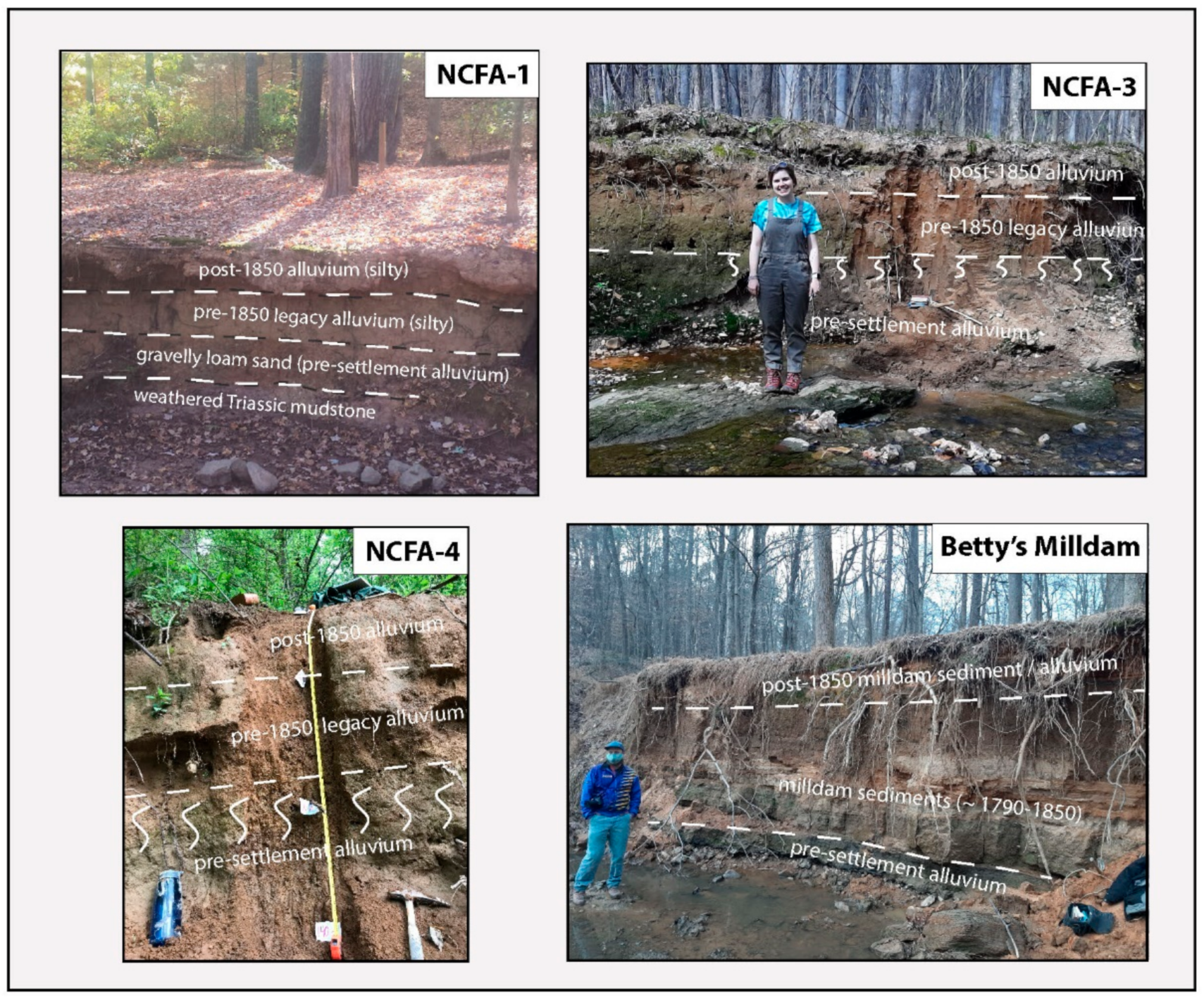
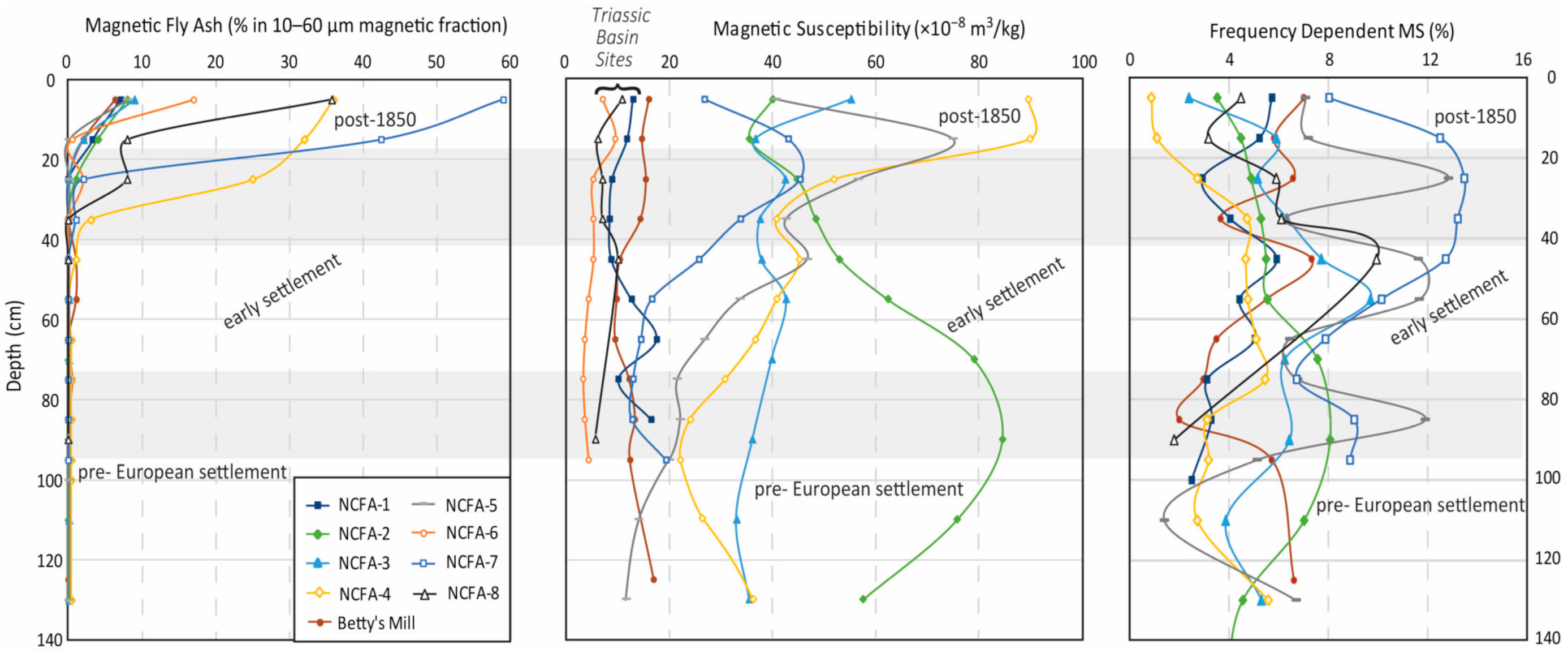
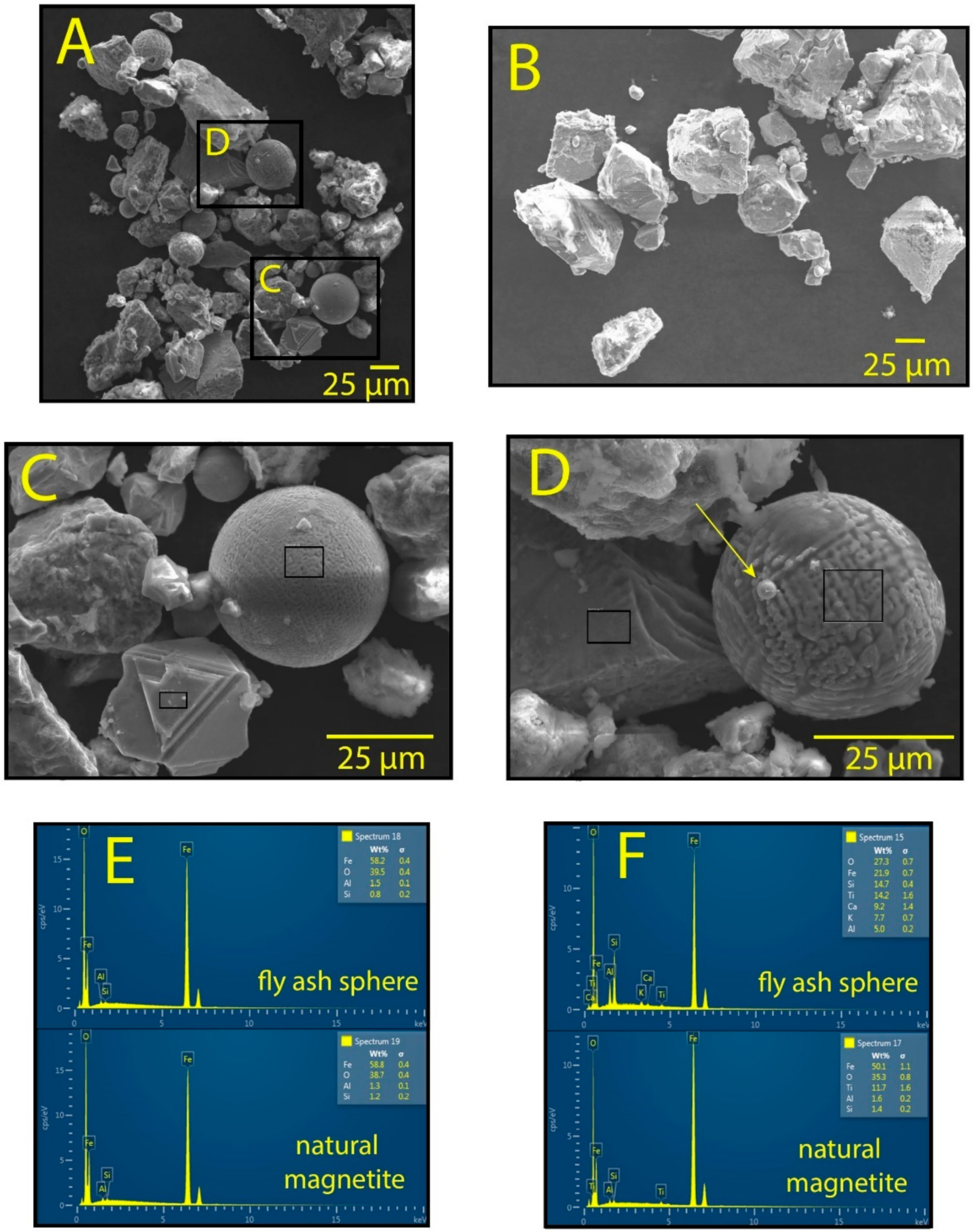

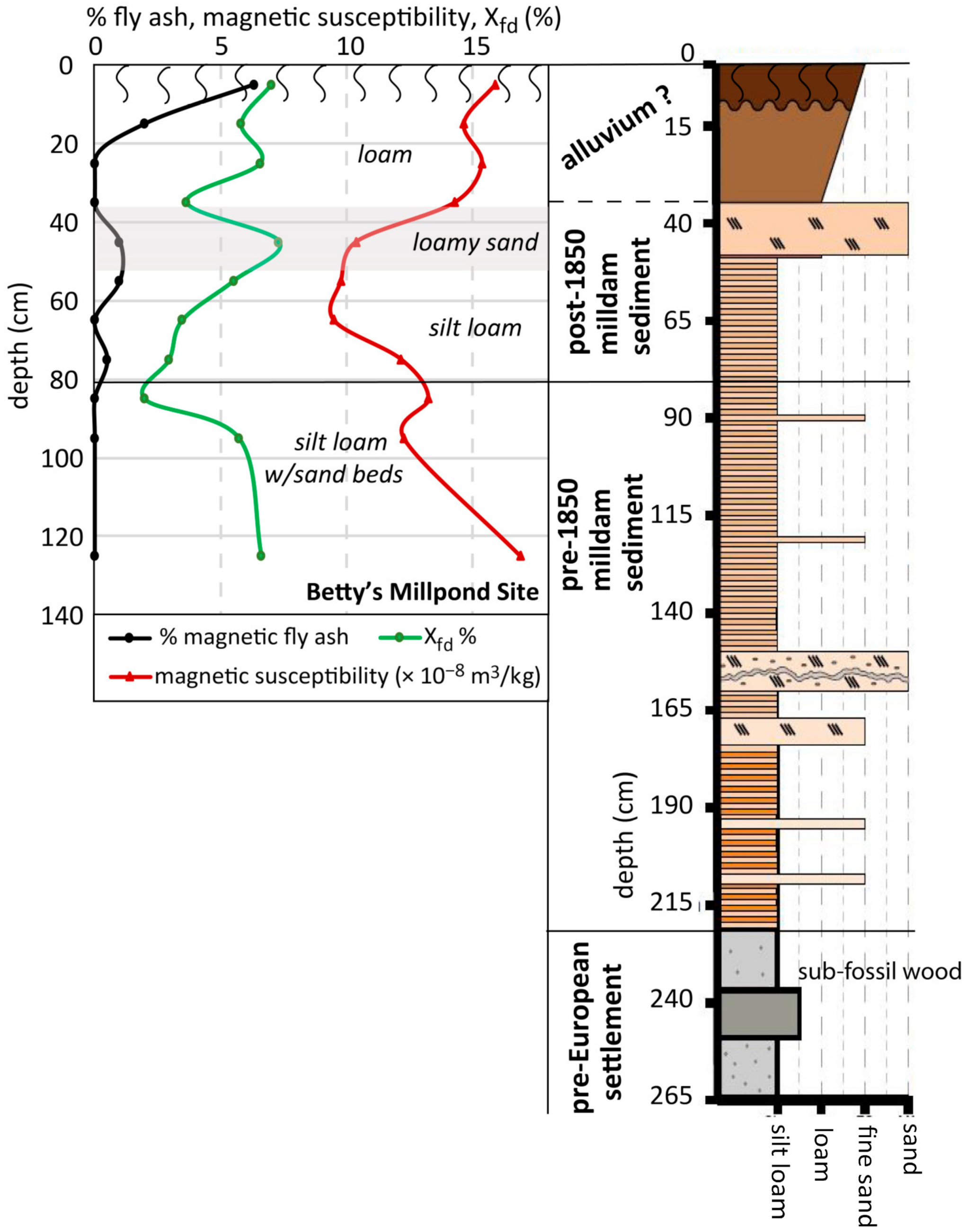
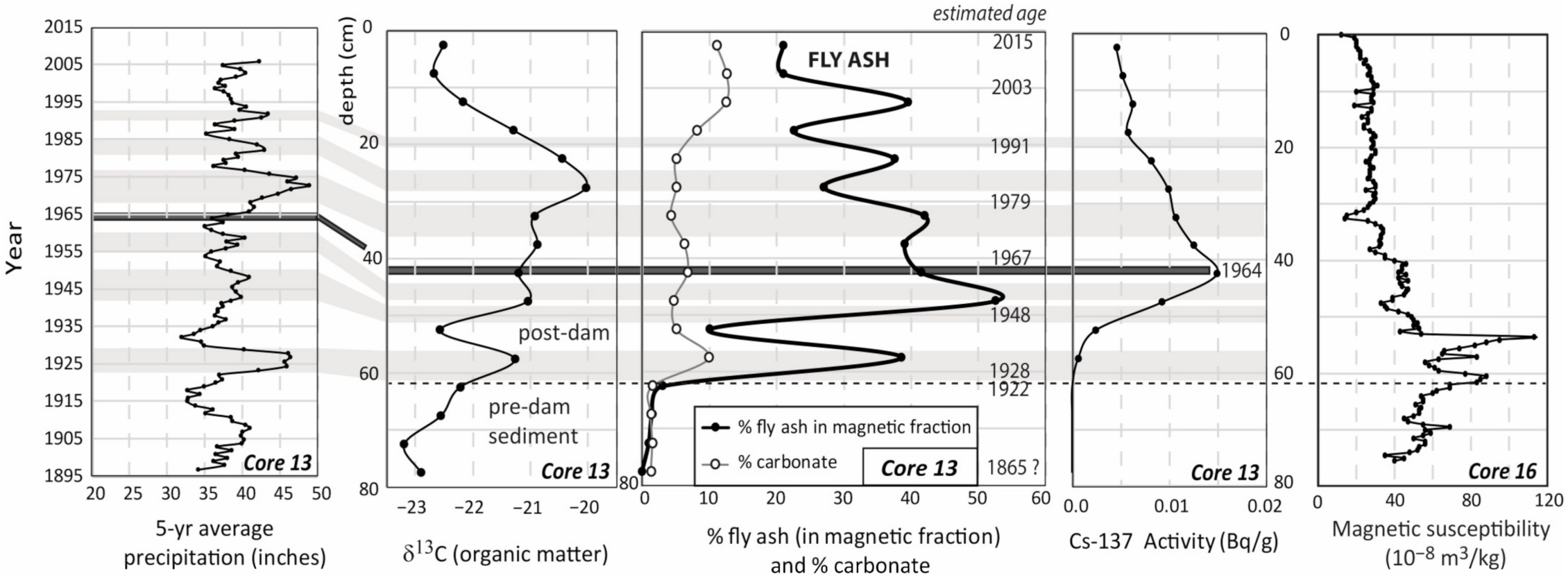

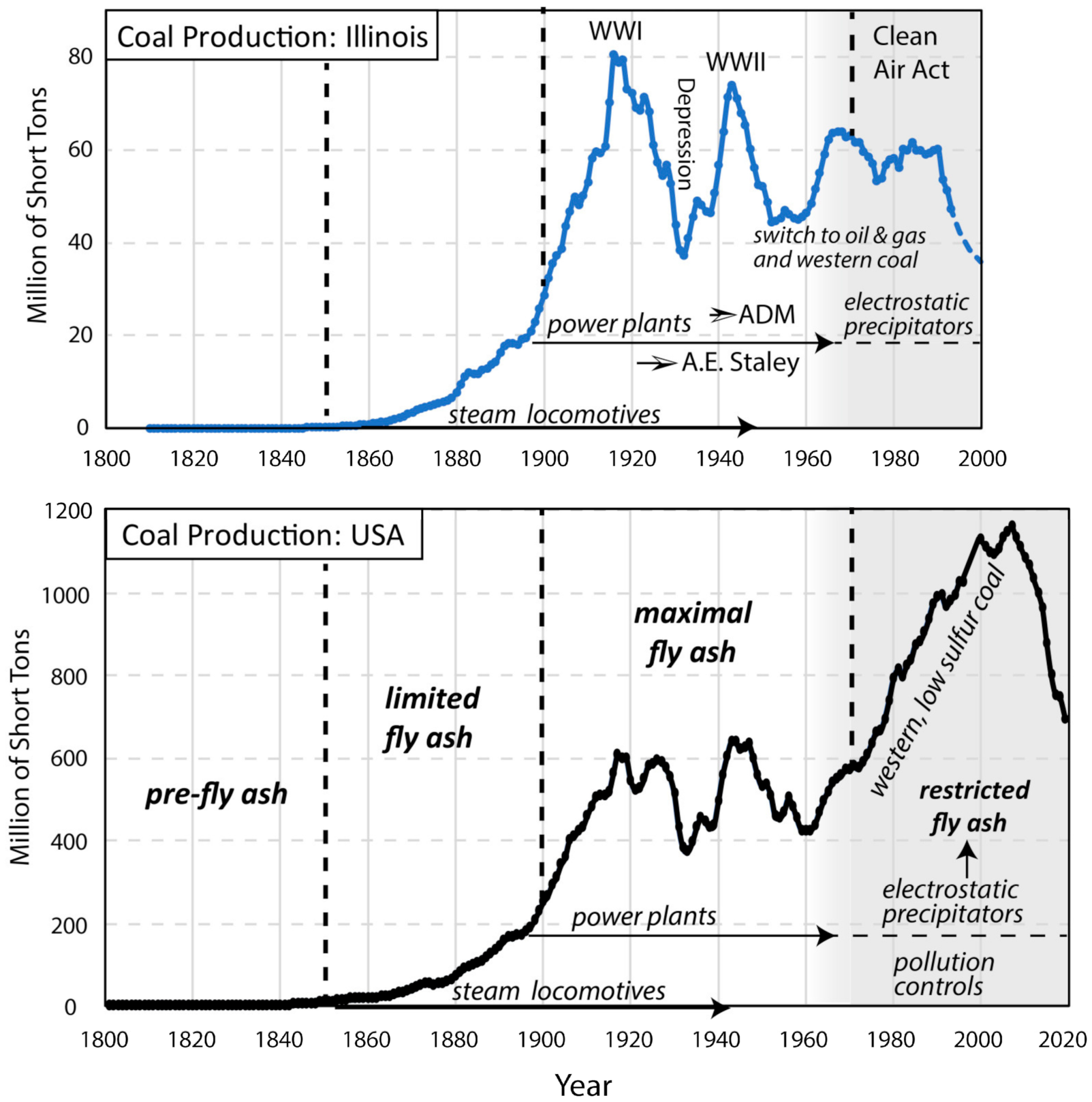
| Site Name | Latitude | Longitude | Location | Max.% Fly Ash# | Mean MS (×10−8 m3/kg) | Post-1850 PSA Thickness (cm) | Valley Width (m) | Geo-Terrain |
|---|---|---|---|---|---|---|---|---|
| NCFA-1 | 35.77820 | −78.83608 | near Taylor YMCA; Wake Co., NC | 5 | 12 | 20 | 85 | Triassic Basin |
| NCFA-2 | 35.82600 | −78.78440 | Black Creek, Wake Co., NC | 8 | 58 | 30 | 95 | Metavolcanic epiclastic |
| NCFA-3 | 35.82310 | −78.78480 | Black Creek, Wake Co., NC | 9 | 40 | 20 | 55 | Metavolcanic epiclastic |
| NCFA-4 | 35.92730 | −79.03970 | Chapel Hill, Orange Co., NC | 36 | 44 | 45 | 235 | Metamorphosed granite |
| NCFA-5 | 35.93950 | −79.08540 | Chapel Hill, Orange Co., NC | 8 | 34 | 15 | 125 | Felsic metavolcanics |
| NCFA-6 | 35.76691 | −78.83589 | near Westhigh St., Wake Co., NC | 17 | 5 | 30 | 100 | Triassic Basin |
| NCFA-7 | 35.56043 | −79.05435 | Lee Co., NC, Moncure Quad | 59 | 25 | 40 | 450 | Triassic Basin |
| NCFA-8 | 35.65618 | −79.89396 | Holly Springs Road, Wake Co., NC | 36 | 8 | 30 | 350 | Triassic Basin |
| Bettys Milldam | 35.83000 | −78.75390 | Umstead Park, Wake Co., NC | 6 | 13 | 80 (milldam) | 95 | Metamorphosed granite |
Publisher’s Note: MDPI stays neutral with regard to jurisdictional claims in published maps and institutional affiliations. |
© 2021 by the authors. Licensee MDPI, Basel, Switzerland. This article is an open access article distributed under the terms and conditions of the Creative Commons Attribution (CC BY) license (https://creativecommons.org/licenses/by/4.0/).
Share and Cite
Grimley, D.A.; Lynn, A.S.; Brown, C.W.; Blair, N.E. Magnetic Fly Ash as a Chronological Marker in Post-Settlement Alluvial and Lacustrine Sediment: Examples from North Carolina and Illinois. Minerals 2021, 11, 476. https://doi.org/10.3390/min11050476
Grimley DA, Lynn AS, Brown CW, Blair NE. Magnetic Fly Ash as a Chronological Marker in Post-Settlement Alluvial and Lacustrine Sediment: Examples from North Carolina and Illinois. Minerals. 2021; 11(5):476. https://doi.org/10.3390/min11050476
Chicago/Turabian StyleGrimley, David A., Ashley S. Lynn, Colby W. Brown, and Neal E. Blair. 2021. "Magnetic Fly Ash as a Chronological Marker in Post-Settlement Alluvial and Lacustrine Sediment: Examples from North Carolina and Illinois" Minerals 11, no. 5: 476. https://doi.org/10.3390/min11050476
APA StyleGrimley, D. A., Lynn, A. S., Brown, C. W., & Blair, N. E. (2021). Magnetic Fly Ash as a Chronological Marker in Post-Settlement Alluvial and Lacustrine Sediment: Examples from North Carolina and Illinois. Minerals, 11(5), 476. https://doi.org/10.3390/min11050476






